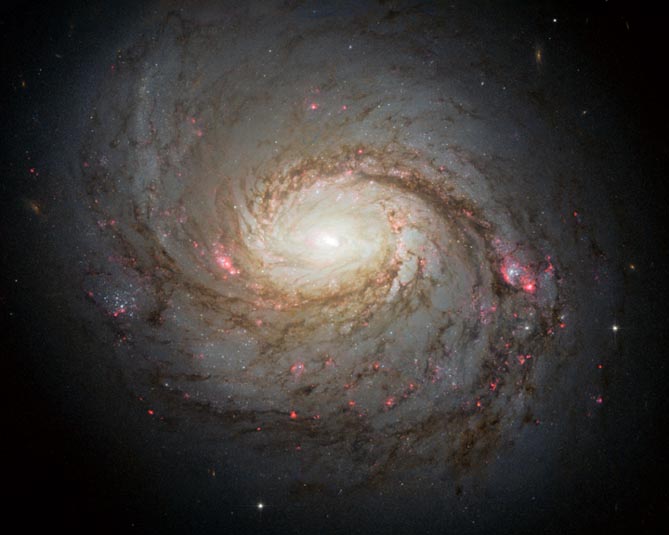
Spiral Galaxy
RA 02hr 42m 40.771s Dec -00° 00' 47.84"
Cetus
45 million light years
7.1' × 6.0' or 170,000 light-years across
9.6
NASA, ESA & A. van der Hoeven
March 28, 2013
ABOUT THIS IMAGE:
The NASA/ESA Hubble Space Telescope has captured this vivid image of spiral galaxy Messier 77, one of the most famous and well-studied galaxies in the sky. The patches of red across this image highlight pockets of star formation along the pinwheeling arms, with dark dust lanes stretching across the galaxy's energetic center.
Messier 77 is a galaxy in the constellation of Cetus, some 45 million light-years away from us. Also known as NGC 1068, it is one of the most famous and well-studied galaxies. It is a real star among galaxies, with more papers written about it than many other galaxies put together!
Despite its current fame and striking swirling appearance, the galaxy has been a victim of mistaken identity a couple of times; when it was initially discovered in 1780, the distinction between gas clouds and galaxies was not known, causing finder Pierre Mechain to miss its true nature and label it as a nebula. It was misclassified again when it was subsequently listed in the Messier Catalogue as a star cluster.
Now, however, it is firmly categorized as a barred spiral galaxy, with loosely wound arms and a relatively small central bulge. It is the closest and brightest example of a particular class of galaxies known as Seyfert galaxies - galaxies that are full of hot, highly ionized gas that glows brightly, emitting intense radiation.
Strong radiation like this is known to come from the heart of Messier 77 - caused by a very active black hole that is around 15 million times the mass of our Sun. Material is dragged towards this black hole and circles around it, heating up and glowing strongly. This region of a galaxy alone, although comparatively small, can be tens of thousands of times brighter than a typical galaxy.
Although
no competition for the intense center, Messier 77's spiral arms are also
very bright regions. Dotted along each arm are knotty red clumps - a signal
that new stars are forming. These baby stars shine strongly, ionizing
nearby gas which then glows a deep red color as seen in the image above.
The dust lanes stretching across this image appear as a rusty, brown-red
color due to a phenomenon known as reddening; the dust absorbs more blue
light than red light, enhancing its apparent redness.
From Wikipedia:
Messier 77 (also known as NGC 1068) is a barred spiral galaxy about 47
million light-years away in the constellation Cetus. Messier 77 is an
active galaxy with an Active Galactic Nucleus (AGN), which is obscured
from view by astronomical dust at visible wavelengths. The diameter of
the molecular disk and hot plasma associated with the obscuring material
was first measured at radio wavelengths by the VLBA and VLA. The hot dust
around the nucleus was subsequently measured in the mid-infrared by the
MIDI instrument at the VLTI. It is the brightest Seyfert galaxy and is
of type 2.
Messier 77 was discovered by Pierre Méchain in 1780, who originally
described it as a nebula. Méchain then communicated his discovery
to Charles Messier, who subsequently listed the object in his catalog.
Both Messier and William Herschel described this galaxy as a star cluster